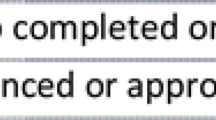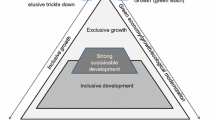Abstract
The vast majority of the twenty-first century societal problems, from climate change and terrorism to hunger and inequality, exist in an increasingly complex, interdependent, and dynamic global context. For example, an intervention to solve a problem of terrorism in one part of the world needs to take into consideration the socio-political stability and resilience in other parts of the world. Addressing these challenges invariably needs to be framed from an ecosystem perspective, where the dependencies and the interactions between the various stakeholders are taken into consideration in the formulation of the solutions. This paper adopts an ecosystem perspective and considers the collaborative role and the intermediary (towards participation of the civil society) function that community-based organizations (CBOs) stand to play with regard to addressing the societal problems as framed within the United Nations 2030 Agenda for Sustainable Development. Using a case study approach, pilot data is presented, from research on a CBO that provides social services to diverse vulnerable population groups in Macau, SAR. This research highlights the unique positioning of the CBO to moderate participation of the marginalized populations groups, and to broker their potential for data collaboration with specific stakeholders within the sustainable development data ecosystem. The paper concludes with a discussion of the opportunities and challenges presented by creating spaces for citizen SDG data reporting and recommendations for adopting existing human rights reporting mechanisms for this purpose.


Similar content being viewed by others
References
Abraham, M. (2006) A new chapter for human rights (Friedrich Ebert Stiftung and International Service for Human Rights). [online]. Available: http://library.fes.de/pdf-files/bueros/genf/ 04375.Pdf [3 December 2014].
Androff, D. (2015) Practicing rights: Human rights-based approaches to social work practice. Routledge. New York.
Boerma, T., Mathers, C., AbouZahr, C., Chatterji, S., Hogan, D., & Stevens, G. (2015). Health in 2015: From MDGs, millennium development goals to SDGs, sustainable development goals. France: World Health Organization.
Bollier, D., & Firestone, C. M. (2010). The promise and peril of big data (p. 56). Washington, DC: Aspen Institute, communications and society program.
Bopp, C., Harmon, E., & Voida, A. (2017). Disempowered by data: Nonprofits, social enterprises, and the consequences of data-driven work. In Proceedings of the 2017 CHI Conference on Human Factors in Computing Systems (pp. 3608–3619). ACM.
Bughin, J., Chui, M., & Manyika, J. (2010). Clouds, big data, and smart assets: Ten tech-enabled business trends to watch. McKinsey Quarterly, 56(1), 75–86.
Cobb, C. W., & Rixford, C. (1998). Lessons learned from the history of social indicators (Vol. 1). San Francisco: Redefining Progress.
Dickerson, F. B., Sommerville, J., Origoni, A. E., Ringel, N. B., & Parente, F. (2002). Experiences of stigma among outpatients with schizophrenia. Schizophrenia Bulletin, 28(1), 143.
Fosso Wamba, S., Akter, S., Edwards, A., Chopin, G., & Gnanzou, D. (2015). How “big data” can make big impact: Findings from a systematic review and a longitudinal case study. International Journal of Production Economics, 165, 234–246. https://doi.org/10.1016/j.ijpe.2014.12.031.
Geiser, A. (2005). Social exclusion and conflict transformation in Nepal: Women, Dalit and ethnic groups. Working Paper 5/2005, Swisspeace, Bern.
Goldkind, L., & Wolf, L. (2015). A digital environment approach: Four technologies that will disrupt social work practice. Social Work, 60(1), 85–87. https://doi.org/10.1093/sw/swu045.
Green, L. (2008). A wink and a nod: Notes from the Arizona borderlands. Dialectical Anthropology, 32(1), 161–167.
Guo, B., Wang, Z., Yu, Z., Wang, Y., Yen, N. Y., Huang, R., & Zhou, X. (2015). Mobile crowd sensing and computing: The review of an emerging human-powered sensing paradigm. ACM Computing Surveys (CSUR), 48(1), 7.
Hák, T., Janoušková, S., & Moldan, B. (2016). Sustainable development goals: A need for relevant indicators. Ecological Indicators, 60, 565–573.
Höchtl, J., Parycek, P., & Schöllhammer, R. (2016). Big data in the policy cycle: Policy decision making in the digital era. Journal of Organizational Computing and Electronic Commerce, 26(1–2), 147–169. https://doi.org/10.1080/10919392.2015.1125187.
Ibrahim, S. S. (2006). From individual to collective capabilities: The capability approach as a conceptual framework for self-help. Journal of Human Development, 7(3), 397–416.
Mayer-Schönberger, V., & Cukier, K. (2013). Big data: A revolution that will transform how we live, work, and think. New York, NY: Houghton Mifflin Harcourt.
McAfee, A., Brynjolfsson, E., & Davenport, T. (2012). Big data: The management revolution. Harvard Business Review, 90(10), 61–67.
Minujin, A., & Ferrer, M. (2016). Assessing sustainable development goals from the standpoint of equity for children. Journal of International and Comparative Social Policy, 32(2), 98–115.
Nelson, T. D. (Ed.). (2004). Ageism: Stereotyping and prejudice against older persons. MIT press.
Ngan, L. L. S., & Chan, K. W. (2013). An outsider is always an outsider: Migration, social policy and social exclusion in East Asia. Journal of Comparative Asian Development, 12(2), 316–350.
Oakes, J. M. (2009). Commentary: Individual, ecological and multilevel fallacies. International journal of epidemiology, 38(2), 361–368.
Pearce, N. (2000). The ecological fallacy strikes back. Journal of Epidemiology and Community Health, 54(5), 326.
Piantadosi, S., Byar, D. P., & Green, S. B. (1988). The ecological fallacy. American journal of epidemiology, 127(5), 893–904.
Pogge, T., & Sengupta, M. (2015). The Sustainable Development Goals (SDGS) as drafted: Nice idea, poor execution. Washington International Law Journal, 24(3), 571.
Robinson, W. S. (1950). Ecological correlations and the behavior of individuals. American Sociological Review 15: 351–57
Saez, E. (2017). Income and wealth inequality: Evidence and policy implications. Contemporary Economic Policy, 35(1), 7–25.
Sedenberg, E., & Hoffmann, A. L. (2016). Recovering the history of informed consent for data science and internet industry research ethics.[online] Available: https://ssrn.com/abstract=2837585
Sen, G., & Mukherjee, A. (2014). No empowerment without rights, no rights without politics: Gender-equality, MDGs and the post-2015 development agenda. Journal of Human Development and Capabilities, 15(2–3), 188–202.
Sen, A. (1999). Development as freedom. Oxford University Press.
Sepuldeva, M., Van Banning, T., & van Genugten, W. (2004). Human rights reference handbook. Costa Rica: University for Peace.
Spijkers, O., & Honniball, A. (2014). MDGs and SDGs: Lessons learnt from global public participation in the drafting of the UN development goals. Vereinte Nationen: German Review on the United Nations, 62(6), 251–256.
Thorat, S., & Newman, K. S. (2007). Caste and economic discrimination: causes, consequences and remedies. Economic and Political Weekly, 4121–4124.
Werker, E., & Ahmed, F. Z. (2008). What do nongovernmental organizations do? The Journal of Economic Perspectives, 22(2), 73–92.
Wolf, L., & Goldkind, L. (2016). Digital native meet friendly visitor: A Flexner-inspired call to digital action. Journal of Social Work Education, 52(sup1), S99-S109.
World Bank. (2002). Non-governmental organizations and civil society engagement in World Bank supported projects: Lessons from OED evaluations. IEG lessons and practices. Washington, DC: World Bank.
Resolution, A. (2015). RES/70/1. Transforming our world: the 2030 agenda for sustainable development. Seventieth United Nations General Assembly, New York, 25.
Volkert, J. (2013). Concepts of agency, sustainable human development (SHD) and collective abilities. Human Development and Capability Association Maitreyee.
Zhang, J., & Dawes, S. S. (2006). Expectations and perceptions of benefits, barriers, and success in public sector knowledge networks. Public Performance & Management Review, 29(4), 433–466.
Zhang, W., & Gutierrez, O. (2007). Information technology acceptance in the social services sector context: An exploration. Social Work, 52(3), 221–231. https://doi.org/10.1093/sw/52.3.221.
Author information
Authors and Affiliations
Corresponding author
Rights and permissions
About this article
Cite this article
Thinyane, M., Goldkind, L. & Lam, H.I. Data Collaboration and Participation for Sustainable Development Goals—a Case for Engaging Community-Based Organizations. J. Hum. Rights Soc. Work 3, 44–51 (2018). https://doi.org/10.1007/s41134-018-0047-6
Published:
Issue Date:
DOI: https://doi.org/10.1007/s41134-018-0047-6




